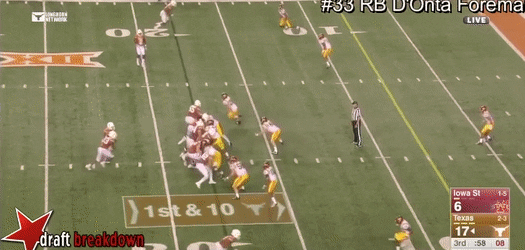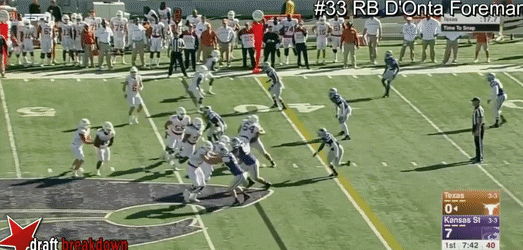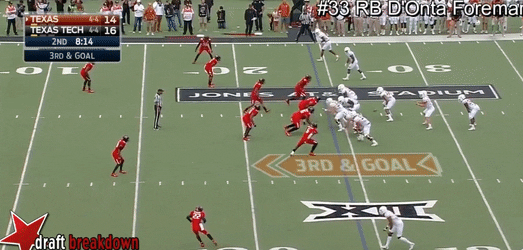Dynasty Debate: D’Onta Foreman vs Christian McCaffrey
The dynasty debates continue, as today we are presenting cases for two more of the outstanding backs in this draft class. We’ve covered the top two in Dalvin Cook and Leonard Fournette, another interesting duo in Wayne Gallman and Alvin Kamara, and now we turn our attention to two more stars. Both D’Onta Foreman and Christian McCaffrey had extremely productive collegiate careers, and here Benton McDonald and Mike Valverde will attempt to convince you why each is worthy of a place on your dynasty rosters.
[am4show have=’g1;’ guest_error=’sub_message’ user_error=’sub_message’ ]
The Case For D’Onta Foreman – Benton McDonald
D’Onta Foreman did not have a game this past season in which he rushed for under 100 yards. The former three star recruit, who many say was only offered by Texas in order to woo his more talented brother Armanti Foreman, quite literally put the Longhorns on his back this season on his way to establishing himself as one of the best running backs in the country. Relatively unknown before the season, Foreman’s rise to be arguably the third-best runner in a class hailed as one of the most talented and deep groups in many years, is a true testament to his talent.
Let’s start with the numbers. The junior amassed 2028 yards on 323 carries, amounting to an incredible 6.3 yards per carry. That efficiency coupled with the volume he received on an otherwise mediocre Texas offense speaks to the unique blend he has of both power and speed. Foreman also scored 15 touchdowns and as mentioned above broke Earl Campbell’s school record with 12 consecutive games with over 100 yards rushing. These gargantuan numbers also led to some hardware, as he won the Doak Walker award given to the nation’s best running back and finished eighth in voting for the Heisman trophy. So yes, in a running back class that even before the season was eliciting giddy reviews from pundits and dynasty owners alike, a junior who was barely on anyone’s radar won the award for best running back.
Living in Austin, I had heard the hype on Foreman and had seen him perform on Saturdays but I had yet to truly buy in until I dove until the film. And to be completely honest, his film blew me away. Like last years Heisman winner Derrick Henry, Foreman is unnaturally fast for his size. Weighing in at 250 pounds, there were times when he broke away from defenders so quickly he looked more like a runner in the Dion Lewis mold. Whether it be towards the sideline on outside zone plays or up the gut on inside runs, he showed time and time again his ability to accelerate both towards the hole and past defenders. The GIF below epitomizes this speed, as he hits the hole on an inside zone play and runs untouched into the endzone:

But what sets Foreman apart from other backs in this class is his size. By seemingly not sacrificing any speed despite weighing more than just about every featured running back in the NFL, Foreman is able to be a bruiser as much as he is a speedster. Rarely if ever did I see him taken down by less than two tacklers, a testament to his power and ability to always keep his feet moving. While some will be quick to label him a plodder based on his size, don’t fall privy to this lazy analysis. His size is certainly beneficial to his game but it’s not defining nor negative to it either.
While I don’t want to compare him to Le’Veon Bell, it’s not entirely far fetched that he could lose some weight once he enters the league and capitalize even further on his athleticism. Because like Bell, Foreman has the vision and patience needed to be a successful running back. To continue on the GIF examples (because I find with scouting incoming rookies it is easier to show than tell), this next one shows Foreman’s vision as mentioned above. He keeps his eyes up the entire time and finds the back-side cut that offensive coaches often scheme to gash defenses.

Foreman’s one jarring weakness that many will point out is his complete lack of skills and production in the passing game. He only caught the ball 13 times in his three years at Texas, with a mere seven in this past season despite being on the field for almost every offensive snap. Yet, while I don’t have any advanced stats to reference, I doubt he ran more than 10-15 routes all season. Texas ran a spread/hurry-up offense under OC Sterlin Gilbert and most of the time had four receivers spread across the field with no tight end and only Foreman in the backfield behind the quarterback. So, with the absence of a tight end and a young, inexperienced offensive line protecting true freshman quarterback Shane Buechele, Foreman was essentially the sixth offensive lineman in passing downs. With a strong base and active eyes, he did a good job in this role, a trait that could be essential to his playing time in the NFL.
Depending on the team, a back that can block on passing downs and schematically understand the complicated blitz pickup system could be more valuable than a pass-catching one. And while I’m not going to act as if Foreman’s lack of catches is not a concern, it’s hard to have a definitive opinion on it when we’ve seen him do it less than ten times. The Combine and his Pro Day will hopefully shed some light on his pass-catching and route running abilities. But, one thing he has shown us on a sufficiently large sample is his ability to block. That’s a plus trait many young running backs take years to develop, and something that will help Foreman separate himself from his peers in this draft class.
While not possessing the talent of the consensus top two backs in this class, Dalvin Cook and Leonard Fournette, I firmly believe Foreman can cement himself as the third best runner in the draft if he builds on his in-season success with a good showing in draft season. Time and time again we’ve seen players fall in the draft after miscues at the combine, whether it be on the field or in the interview room, and lose exponential value despite contrary evidence shown by their tape. His unique combination of size and speed allows for durability while not taking away from the breakaway speed that allowed him to accumulate all those yards this past season. Those two traits are complemented even further by a vision that allows him to find running lanes and cutback holes, a skill paramount to creating yards and advancing the ball, the inherent goal of every handoff. His pass-catching needs help, but don’t rush to let this tank his value because of the fact that he barely if ever ran routes in college. His blocking skills are there, and the ability to protect the quarterback is a skill that will get him repetitions in practice and playing time in games.
Foreman’s landing spot will largely determine his value in rookie drafts, due to the logjam of talent at running back outside of the aforementioned top two in this class. There are scenarios where he goes in the mid first and ones where he goes in the late second. Either way, the talent is there and I believe he can achieve success in the NFL. And if I haven’t convinced you yet, watch this GIF of a Foreman touchdown against Texas Tech this past season.

The Case For Christian McCaffrey – Mike Valverde
Height, weight: 6’2″, 202 lbs (school measurements)
2015 statistics: 337 carries for 2019 yards and eight touchdowns; 45 catches for 645 yards and five TDs; 37 kickoff returns for 1070 yards and one TD; 15 punt returns for 130 yards and one TD.
2016 statistics: 253 carries for 1603 yds and 13 touchdowns; 37 catches for 310 yds and three TDs; 14 kickoff returns for 318 yards and no TDs; ten punt returns for 96 yards and no TDs.
Christian McCaffrey was not considered much of anything before the 2015 season. Everyone had their eyes on either Barry Sanders Jr or senior Remound Wright. In game one against the Penn State Nittany Lions, all three had a share of the carries, but come week two; the ball began to head McCaffrey’s direction. On 20 carries he gained 58 yards and caught a touchdown. This was good enough for him to get another chance, and he took advantage of it.
He would go on to run for more than 100 yards in nine straight games and mixed in two 200-yard contests. He fell six yards short in the victory against Notre Dame but made up for it the following week against USC for his third 200-yard game of the season. He capped his season off against Iowa in the Rose Bowl with a 18-172-0 effort and added 4-105-1 in the passing game. He was recognized with both the Pac-12 Offensive Player of the Year and chosen as an All-American. He also finished second in the Heisman Trophy race.
2016 was not as easy for McCaffrey. He started strong as he ran for three straight 100+ yard games, torching Kansas State, USC, and UCLA for a total of 436 yards and three touchdowns. Then he sputtered at the quarter pole. When facing both Washington and Washington State, he could only gain 85 total yards. He missed the following week with an injury, but came back strong. In his last five games, he averaged close to 225 yards per contest. After posting 169 yards and 199 yards against both Arizona and Oregon State, he saved his best two games for last.
He took advantage of one of the nation’s worst defenses in the California Bears for his best game of the season (31-284-3) and closed it out against Rice where he blew up the stat book once again (30-204-1; 2-23-1). He chose not to play in the bowl game for Stanford, instead choosing to work on becoming an NFL running back.
The Christian McCaffrey DNA is a mixture of a family that should have the last name “athleticism.” He is the son of former NFL wide receiver Ed McCaffrey (Denver Broncos). His mother, Lisa, played soccer at Stanford. His grandfather, David Sime, won the silver medal in the 100-meter dash at the 1960 Summer Olympics. His brother Max recently starred at wide receiver for Duke. He has various other uncles and aunts who competed at the college level in basketball, tennis, football and wrestling.
Many are going to point to head coach David Shaw who has made both Stepfan Taylor (2,860 rushing yards from 2011-12) and Tyler Gaffney (1,709 in 2013) look good, then watch them falter in the NFL. But neither possess the ability of McCaffrey and both were not considered high-value draft picks. Gaffney went to the Panthers in the sixth round, while Taylor went in the fifth to the Cardinals.
McCaffrey isn’t your typical running back, as he can be do a multitude of things for a team. He can be the receiver in the slot, the running back that can swing from outside of the backfield and has a wicked one-cut that can get him into the end zone. He is also a person on special teams that can return punts and kicks. Think of Dion Lewis from the Patriots with more all-around skill.
He has an amazing burst that gets him to the hole and once he is in he can explode. He has the vision to pick where the hole is opening and which direction the defense is leaning. His balance and light feet allow him the patience to set up the blocks and throttle through without losing any speed while making defenders miss. His thick frame allows him to absorb linebacker’s force and bounce off them, while his speed around the corner beats defenders.
As stated, he catches the ball like a receiver. He snags the ball away from his frame and can catch over the shoulder. McCaffrey is an excellent route-runner, incorporating subtle shoulder fakes to leave defenders guessing, creating easy separation. He has been trained by his father in this area because he has that receiver quality few running backs possess.
He has one major drawback, and that is his size. He just isn’t big enough to hold down a blocking role in the backfield. He doesn’t mind getting into the mix, but bigger defenders are going to shot-put him. I would not be surprised to see him playing a third or fourth wide receiver while a more rugged running back stays in for blocking. He also has a hard time locking in on the defenders once in contact.
I see McCaffrey as either the second or third running back off the NFL draft board this season. He has the talent to be everywhere and add throw in the bonus of special teams. He would fit in nicely with teams such as the Oakland Raiders, New York Jets, Green Bay Packers, or perhaps even the Denver Broncos.
[/am4show]
- Rookie Profile: Deshaun Watson, QB Clemson - April 23, 2017
- 20/20: Leonard Fournette - February 28, 2017
- Dynasty Debate: D’Onta Foreman vs Christian McCaffrey - February 5, 2017

































































